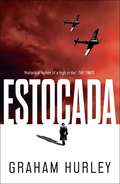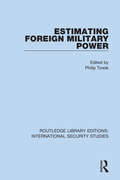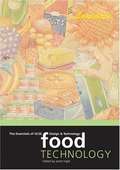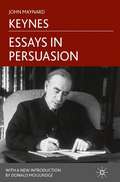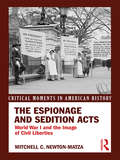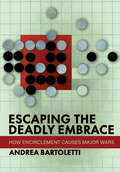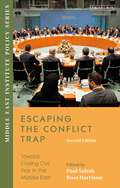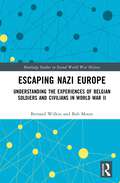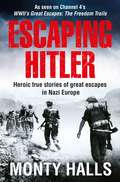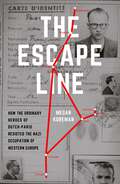- Table View
- List View
Estocada: Wars Within Book 3 (Spoils of War #3)
by Graham Hurley'Historical fiction of a high order' The Times 1937. Flying for the infamous Condor Legion over the battlefields of Spain's civil war, Merz has been able to unleash the fearsome potential of the Luftwaffe's newest weapon against his opponents. In Dieter's hands, the Messerschmitt Bf-109 is as graceful as a matador's killing strike: la estocada.Scotsman and ex-marine Tam Moncrieff is recruited by a nameless intelligence agency in London to go to Germany and sound out Hitler's resolve. Does he really intend to invade Czechoslovakia? Do his generals support him? Can the march to war be stopped?As duty collides with conscience, fate will bring both men together. In a world wedded to violence and ambition, desperate steps must be taken. To avoid war a killing strike is needed.The question is, who is the matador, who is the bull?Estocada is part of the SPOILS OF WAR Collection, a thrilling, beguiling blend of fact and fiction born of some of the most tragic, suspenseful, and action-packed events of World War II. From the mind of highly acclaimed thriller author GRAHAM HURLEY, this blockbuster non-chronological collection allows the reader to explore Hurley's masterful storytelling in any order, with compelling recurring characters whose fragmented lives mirror the war that shattered the globe.
Estimating Foreign Military Power (Routledge Library Editions: International Security Studies #6)
by Philip TowleThis book, first published in 1982, addresses the problem of assessing the central and regional balance of power. The collection of essays by experts on the different countries looks at the miscalculations about the military power of foreign countries which have been made in the past and the difficulties which have to be overcome today before we can reach a correct estimate of the power of other states.
Estimating Foreign Military Power (Routledge Library Editions: International Security Studies #6)
by Philip TowleThis book, first published in 1982, addresses the problem of assessing the central and regional balance of power. The collection of essays by experts on the different countries looks at the miscalculations about the military power of foreign countries which have been made in the past and the difficulties which have to be overcome today before we can reach a correct estimate of the power of other states.
Esther Simpson: The True Story of her Mission to Save Scholars from Hitler's Persecution
by John EidinowMany of the academic refugees Esther Simpson helped rescue are well remembered. But who was she and why has history forgotten her?This is the story of Esther Simpson, a woman whose dedication to the cause of freedom in science and learning left an indelible mark on the cultural and intellectual landscape of the modern world.Esther Simpson - Tess to her friends - devoted her life to resettling academic refugees, whom she thought of as her family. By the end of her life, Simpson could count among her 'children' sixteen Nobel Prize winners, eighteen Knights, seventy-four fellows of the Royal Society, thirty-four fellows of the British Academy. Her 'children' made a major contribution to Allied victory in World War Two.From a humble upbringing in Leeds to Russian immigrant parents, Simpson took on secretarial roles that saw her move to Paris, Vienna and Geneva. But when Hitler assumed power in 1933, she took a job in London at the Academic Assistance Council, newly set up to rescue displaced German scholars, and found her lifelong calling.For a woman who befriended so many and such eminent 'children', surprisingly little is known of her. This book is a study of Esther Simpson: who she was and how she lived, what moved her to take up and never to relinquish her calling, her impact on the world, and the historical context that helped shape her achievements.
Essex-Class Aircraft Carriers 1945–91 (New Vanguard)
by Mark StilleA history of the enduring Essex-class ships, the US Navy's finest and most numerous fleet carrier during World War II, which were modernized repeatedly and served with distinction.The Essex class was the USN's war-winning ship class of the Pacific War. Of the 24 ships completed, 14 saw action, making the Essex class the largest class of fleet aircraft carriers ever built. These ships had a fine balance of striking power, protection, and speed and were modernized during and after the war. There were five distinct programs carried out, adding not only angled flight decks for jet operations, but repeated upgrades to sensors, weapons, and equipment.Essex-class carriers were used in a number of roles and provided the vast majority of US Navy air power in the Korean War, and a sizeable proportion of air power in the Vietnam conflict. However, as the “super carriers” began to enter service in the early 1960s, the Essex class was relegated to secondary roles– a single Essex carrier served until 1991 as the US Navy's training carrier. This book provides an in-depth portrait of this important and enduring class of ship, and looks at its development and modifications while considering the many and varied actions it took part in.
Essex-Class Aircraft Carriers 1945–91 (New Vanguard)
by Mark StilleA history of the enduring Essex-class ships, the US Navy's finest and most numerous fleet carrier during World War II, which were modernized repeatedly and served with distinction.The Essex class was the USN's war-winning ship class of the Pacific War. Of the 24 ships completed, 14 saw action, making the Essex class the largest class of fleet aircraft carriers ever built. These ships had a fine balance of striking power, protection, and speed and were modernized during and after the war. There were five distinct programs carried out, adding not only angled flight decks for jet operations, but repeated upgrades to sensors, weapons, and equipment.Essex-class carriers were used in a number of roles and provided the vast majority of US Navy air power in the Korean War, and a sizeable proportion of air power in the Vietnam conflict. However, as the “super carriers” began to enter service in the early 1960s, the Essex class was relegated to secondary roles– a single Essex carrier served until 1991 as the US Navy's training carrier. This book provides an in-depth portrait of this important and enduring class of ship, and looks at its development and modifications while considering the many and varied actions it took part in.
The Essentials of GCSE Design & Technology: Food Technology (PDF)
by Judith Sunderland Angela Tooley Christine Finch Janet InglisThis book has been designed to support students in the area of Design and Technology: Food Technology at GCSE. It presents key areas in an attractive, uncomplicated way, taking into account different learning styles. It may be used throughout the course as an aid to teaching, during the Long Task as a support and finally as a revision guide prior to the final exams.
The Essential Guide to Airsoft Gear
by Bloomsbury PublishingThe Essential Guide to Airsoft Gear provides the perfect introduction to assembling some of the most sought-after gear you need to look the part on the skirmish field. Featuring iconic loadouts from units such as 22 SAS at the time of Bravo Two Zero, US Army Rangers and Delta at the Battle of Mogadishu, through to the modern-day Russian Special Forces of the Alpha Group, it covers in detail how to recreate the uniforms and equipment worn by each troop type and explains how to source the different elements from Airsoft kit retailers.Produced in conjunction with Airsoft International, the world's best-selling Airsoft magazine, this is the definitive guide to some of the most popular and distinctive loadouts ever seen on the skirmish fields of the Airsoft world.
The Essential Guide to Airsoft Gear
by Bloomsbury PublishingThe Essential Guide to Airsoft Gear provides the perfect introduction to assembling some of the most sought-after gear you need to look the part on the skirmish field. Featuring iconic loadouts from units such as 22 SAS at the time of Bravo Two Zero, US Army Rangers and Delta at the Battle of Mogadishu, through to the modern-day Russian Special Forces of the Alpha Group, it covers in detail how to recreate the uniforms and equipment worn by each troop type and explains how to source the different elements from Airsoft kit retailers.Produced in conjunction with Airsoft International, the world's best-selling Airsoft magazine, this is the definitive guide to some of the most popular and distinctive loadouts ever seen on the skirmish fields of the Airsoft world.
The Essential Clausewitz: Selections from On War
by Joseph I. Greene Carl Von ClausewitzSuccinct edition of the influential work, from its observations on the nature and theory of warfare to its outlines of strategic policies: moral force and military virtues, duration and decision of combat, effects of victory and retreat, tactics of offense and defense, planning, and wartime politics.
The Essential Art of War
by Ralph D. SawyerRalph D. Sawyer is the preeminent scholar and translator on Sun-tzu's masterful work. More than 200,000 copies of his Sun-tzu Art of War and more than 55,000 copies of The Complete Art of War have been sold. The Art of War is the most famous study of strategy ever written and has had an extraordinary influence on the history of warfare. The Essential Art of War brings Sun-tzu's classic work to a new, uninitiated readership. This clear and compact volume presumes no prior knowledge of the subject and presents only the material that is essential to understanding this text. Using his best-selling Art of War translation as the centerpiece, Sawyer has re-approached every chapter to include an introduction and closing commentary that deliver the key concepts. An introduction to the volume on the relevance of Sun-tzu's teachings, a chronology, historical background on the translation itself, and a bibliographic essay are also included. The Essential Art of War is presented in an attractive 208-page hardcover volume with foiled jacket, stamped case, and ribbon marker, in a convenient gift size.
The Essence Of War: Leadership And Strategy From The Chinese Military Classics
by Ralph D. SawyerFrom antiquity, the history of China has been marked by invading tribes, warring states, and popular uprisings. This heritage of conflict produced a body of martial literature exploring the fundamental principles of warfare and their methods of employment. Fully aware of the tragic consequences of battle, the authors of these texts emphasized that bloodshed and war should be avoided whenever possible. But, they argued, this is possible only when the principles of leadership and strategy have been mastered and the dynamics of conflict thoroughly analyzed. Over the centuries, these texts have been studied throughout Asia, not only by generals on the battlefield but by leaders of all kinds concerned with the management of human conflict in all its forms.The Essence of War presents eight of these classics (written from 500 B.C.E. to 700 C.E.), including Sun-tzu's Art of War and Sun Pin's Military Methods. The book introduces the core principles of Chinese military science, grouping selected passages and key quotations into five thematic sections encompassing forty-one topical chapters: Fundamentals, Tao of Warfare, Tao of Command, Tactical Essentials, and Tactical Specifics. Translator Ralph D. Sawyer provides here a concise introduction to Chinese military thought and influential materials not only of traditional import, but also for contemporary study and enduring value in both business and military circles throughout the world.
Essays In Persuasion (PDF)
by John Maynard KeynesThis reissue of the authoritative Royal Economic Society edition of Essays in Persuasion features a new introduction by Donald Moggridge, which discusses the significance of this definitive work. The essays in this volume show Keynes' attempts to influence the course of events by public persuasion over the period of 1919-40.
Espionage: Past, Present and Future? (Studies in Intelligence)
by Wesley K. WarkHighlights of the volume include pioneering essays on the methodology of intelligence studies by Michael Fry and Miles Hochstein, and the future perils of the surveillance state by James Der Derian. Two leading authorities on the history of Soviet/Russian intelligence, Christopher Andrew and Oleg Gordievsky, contribute essays on the final days of the KGB. Also, the mythology surrounding the life of Second World War intelligence chief, Sir William Stephenson, The Man Called Intrepid', is penetrated in a persuasive revisionist account by Timothy Naftali. The collection is rounded off by a series of essays devoted to unearthing the history of the Canadian intelligence service.
Espionage: Past, Present and Future? (Studies in Intelligence)
by Wesley K. WarkHighlights of the volume include pioneering essays on the methodology of intelligence studies by Michael Fry and Miles Hochstein, and the future perils of the surveillance state by James Der Derian. Two leading authorities on the history of Soviet/Russian intelligence, Christopher Andrew and Oleg Gordievsky, contribute essays on the final days of the KGB. Also, the mythology surrounding the life of Second World War intelligence chief, Sir William Stephenson, The Man Called Intrepid', is penetrated in a persuasive revisionist account by Timothy Naftali. The collection is rounded off by a series of essays devoted to unearthing the history of the Canadian intelligence service.
The Espionage and Sedition Acts: World War I and the Image of Civil Liberties (Critical Moments in American History)
by Mitchell Newton-MatzaThe Espionage and Sedition Acts of 1917-1918 mark one of the most controversial moments in American history. Even as President Woodrow Wilson justified US entry into World War I on the grounds that it would "make the world safe for democracy," the act curtailed civil liberties at home by making it illegal to speak out against the US participation in the conflict. Supporters of the Acts argued that these measures were necessary to protect national security and keep in check the perceived threat of radical activities, while opponents considered them an unjustifiable breach of the Bill of Rights. The conflict between government powers and civil liberties concretized by the Acts continues to resonate today. The Espionage and Sedition Acts introduces students to this controversial set of laws, the cultural and political context in which they were passed, and their historical ramifications. In a concise narrative supplemented by primary sources including court cases, newspaper articles, and personal papers, Mitchell C. Newton-Matza gives students of history and politics a nuanced understanding of this key event.
The Espionage and Sedition Acts: World War I and the Image of Civil Liberties (Critical Moments in American History)
by Mitchell Newton-MatzaThe Espionage and Sedition Acts of 1917-1918 mark one of the most controversial moments in American history. Even as President Woodrow Wilson justified US entry into World War I on the grounds that it would "make the world safe for democracy," the act curtailed civil liberties at home by making it illegal to speak out against the US participation in the conflict. Supporters of the Acts argued that these measures were necessary to protect national security and keep in check the perceived threat of radical activities, while opponents considered them an unjustifiable breach of the Bill of Rights. The conflict between government powers and civil liberties concretized by the Acts continues to resonate today. The Espionage and Sedition Acts introduces students to this controversial set of laws, the cultural and political context in which they were passed, and their historical ramifications. In a concise narrative supplemented by primary sources including court cases, newspaper articles, and personal papers, Mitchell C. Newton-Matza gives students of history and politics a nuanced understanding of this key event.
Escaping the Deadly Embrace: How Encirclement Causes Major Wars (Cornell Studies in Security Affairs)
by Andrea BartolettiEncirclement, Andrea Bartoletti argues, is an essential strategic possibility of the international system and a key trigger of major war. Using historical case studies, Escaping the Deadly Embrace examines how great powers try to escape the two-front war problem and seek to preserve their security. Encirclement is a geographic variable that occurs in the presence of one or two great powers on two different borders of the surrounded great power. The surrounding great powers may not have the capacity to initiate a joint invasion. Yet their threatening presence triggers a double security dilemma for the encircled great power, which has to disperse its army to secure its borders. When the surrounding great powers become capable of launching a two-front attack, the encircled great power initiates war. This situation, disastrous in itself, can also lead to war contagion when other great powers intervene in the new conflict owing to the rival-based network of alliances. Combining archival work and historiographical analysis, Escaping the Deadly Embrace demonstrates the efficacy of this by assessing three major wars: the Italian Wars, the Thirty Years' War, and World War I. These findings, Bartoletti shows, have important implications for future major wars. Challenging the current focus on the US-China rivalry, he argues that the most concerning strategic scenario is the encirclement of China by India and Russia.
Escaping the Conflict Trap: Toward Ending Civil War in the Middle East (Middle East Institute Policy Series)
by Paul Salem and Ross HarrisonHow can the current civil wars in the Middle East be resolved? This volume brings together academics, experts, and practitioners to explore this question. The book covers the history of civil wars in the region during the 20th century, and then examines the specific causes, drivers, and dynamics of the ongoing civil wars in Syria, Yemen, Libya, Afghanistan, and Iraq.Updated for a second edition, the book argues that while these are very different cases of civil war, there are patterns that are important to point out at the outset. First, while each of the conflicts appears to be a relatively recent phenomenon, each has a long historical tail. Second, each of the civil wars had deep and complex domestic drivers and dynamics over issues of governance, political identity, and resources; at the same time, all of the conflicts have had deep regional and international components. Finally, all of these civil wars have been affected by the presence or entrance of armed transnational non-state actors, which have had far greater involvement in the Middle Eastern civil wars compared to other regions. The book concludes that these conflicts will require a mixture of local, regional, and international interventions to bring them to an end, but that none of the conflicts are likely to end cleanly through either a negotiated settlement or a clear victory by one party or the other.Despite this pessimistic overall assessment, the book emphasizes that policymakers should use knowledge of civil wars in the Middle East to develop and pursue specific national, regional and global policies. These should be built around mitigating the worst effects of the conflicts and towards ultimate resolution.
Escaping the Conflict Trap: Toward Ending Civil War in the Middle East (Middle East Institute Policy Series)
How can the current civil wars in the Middle East be resolved? This volume brings together academics, experts, and practitioners to explore this question. The book covers the history of civil wars in the region during the 20th century, and then examines the specific causes, drivers, and dynamics of the ongoing civil wars in Syria, Yemen, Libya, Afghanistan, and Iraq.Updated for a second edition, the book argues that while these are very different cases of civil war, there are patterns that are important to point out at the outset. First, while each of the conflicts appears to be a relatively recent phenomenon, each has a long historical tail. Second, each of the civil wars had deep and complex domestic drivers and dynamics over issues of governance, political identity, and resources; at the same time, all of the conflicts have had deep regional and international components. Finally, all of these civil wars have been affected by the presence or entrance of armed transnational non-state actors, which have had far greater involvement in the Middle Eastern civil wars compared to other regions. The book concludes that these conflicts will require a mixture of local, regional, and international interventions to bring them to an end, but that none of the conflicts are likely to end cleanly through either a negotiated settlement or a clear victory by one party or the other.Despite this pessimistic overall assessment, the book emphasizes that policymakers should use knowledge of civil wars in the Middle East to develop and pursue specific national, regional and global policies. These should be built around mitigating the worst effects of the conflicts and towards ultimate resolution.
Escaping Nazi Europe: Understanding the Experiences of Belgian Soldiers and Civilians in World War II (Routledge Studies in Second World War History)
by Bernard Wilkin Bob MooreThis book chronicles the escapes attempted by Belgian soldiers and civilians from Nazi-occupied Europe during the Second World War. Insofar as is practical, the authors have tried to let the subjects speak for themselves by making extensive use of their testimonies preserved in archives in Belgium and the United Kingdom. The book begins with the stories of soldiers who managed to evade capture in the summer of 1940 and returned home, and the few that decided to continue the fight and joined the Allied forces in the United Kingdom. It also includes the prisoners of war who managed to escape from camps or Arbeitskommando inside the Reich and provides a detailed analysis of their narratives: their motivation for going on the run, their choices on when and how to travel, and the many obstacles they encountered along the way. Most escapees were content to return home, with some then joining resistance organisations, but a small minority were committed to joining the Allies, and further chapters recount their attempts to reach Spain and Switzerland, and the additional problems they encountered in those neutral states. Final chapters reflect on the penalties inflicted on prisoners of war who were recaptured and on the escapees’ struggle for recognition in the post-war world.
Escaping Nazi Europe: Understanding the Experiences of Belgian Soldiers and Civilians in World War II (Routledge Studies in Second World War History)
by Bernard Wilkin Bob MooreThis book chronicles the escapes attempted by Belgian soldiers and civilians from Nazi-occupied Europe during the Second World War. Insofar as is practical, the authors have tried to let the subjects speak for themselves by making extensive use of their testimonies preserved in archives in Belgium and the United Kingdom. The book begins with the stories of soldiers who managed to evade capture in the summer of 1940 and returned home, and the few that decided to continue the fight and joined the Allied forces in the United Kingdom. It also includes the prisoners of war who managed to escape from camps or Arbeitskommando inside the Reich and provides a detailed analysis of their narratives: their motivation for going on the run, their choices on when and how to travel, and the many obstacles they encountered along the way. Most escapees were content to return home, with some then joining resistance organisations, but a small minority were committed to joining the Allies, and further chapters recount their attempts to reach Spain and Switzerland, and the additional problems they encountered in those neutral states. Final chapters reflect on the penalties inflicted on prisoners of war who were recaptured and on the escapees’ struggle for recognition in the post-war world.
Escaping Hitler: Stories Of Courage And Endurance On The Freedom Trails
by Monty Halls‘I was on a train, and a German soldier began shouting at me and poking me in the ribs with his machine gun. I just thought that was it, the game was up . . .’Downed airman Bob Frost faced danger at every turn as he was smuggled out of France and over the Pyrenees. Prisoner of war Len Harley went on the run in Italy, surviving months in hiding and then a hazardous climb over the Abruzzo mountains with German troops hot on his heels. These are just some of the stories told in heart-stopping detail as Monty Halls takes us along the freedom trails out of occupied Europe, from the immense French escape lines to lesser-known routes in Italy and Slovenia. Escaping Hitler features spies and traitors, extraordinary heroism from those who ran the escape routes and offered shelter to escapees, and great feats of endurance. The SAS in Operation Galia fought for forty days behind enemy lines in Italy and then, exhausted and pursued by the enemy, exfiltrated across the Apennine mountains. And in Slovenia Australian POW Ralph Churches and British Les Laws orchestrated the largest successful Allied escape of the entire war.Mixing new research, interviews with survivors and his own experience of walking the trails, Monty brings the past to life in this dramatic and gripping slice of military history.
Escape With The Navy Seal (The Riley Code #3)
by Regan BlackCan a hostage couple defeat their captor?
ESCAPE LINE C: How the Ordinary Heroes of Dutch-Paris Resisted the Nazi Occupation of Western Europe
by Megan KoremanOf all the resistance organizations that operated during the war, about which much has been written, one stands out for its transnational character, the diversity of the tasks its members took on, and the fact that, unlike many of the known evasion lines, it was not directed by Allied officers, but rather by group of ordinary citizens. Between 1942 and 1945, they formed a network to smuggle Dutch Jews and others targeted by the Nazis south into France, via Paris, and then to Switzerland. This network became known as the Dutch-Paris Escape Line, eventually growing to include 300 people and expanding its reach into Spain. Led by Jean Weidner, a Dutchman living in France, many lacked any experience in clandestine operations or military tactics, and yet they became one of the most effective resistance groups of the Second World War. Dutch-Paris largely improvised its operations-scrounging for food on the black market, forging documents, and raising cash. Hunted relentlessly by the Nazis, some were even captured and tortured. In addition to Jews, those it helped escape the clutches of the Nazis included resistance fighters, political foes, Allied airmen, and young men looking to get to London to enlist. As the need grew more desperate, so did the bravery of those who rose to meet it. Using recently declassified archives, The Escape Line tells the story of the Dutch-Paris and the thousands of people it saved during World War II. Author Megan Koreman, who was given exclusive access to many of the archives, is herself the daughter of Dutch parents who were part of the resistance.
